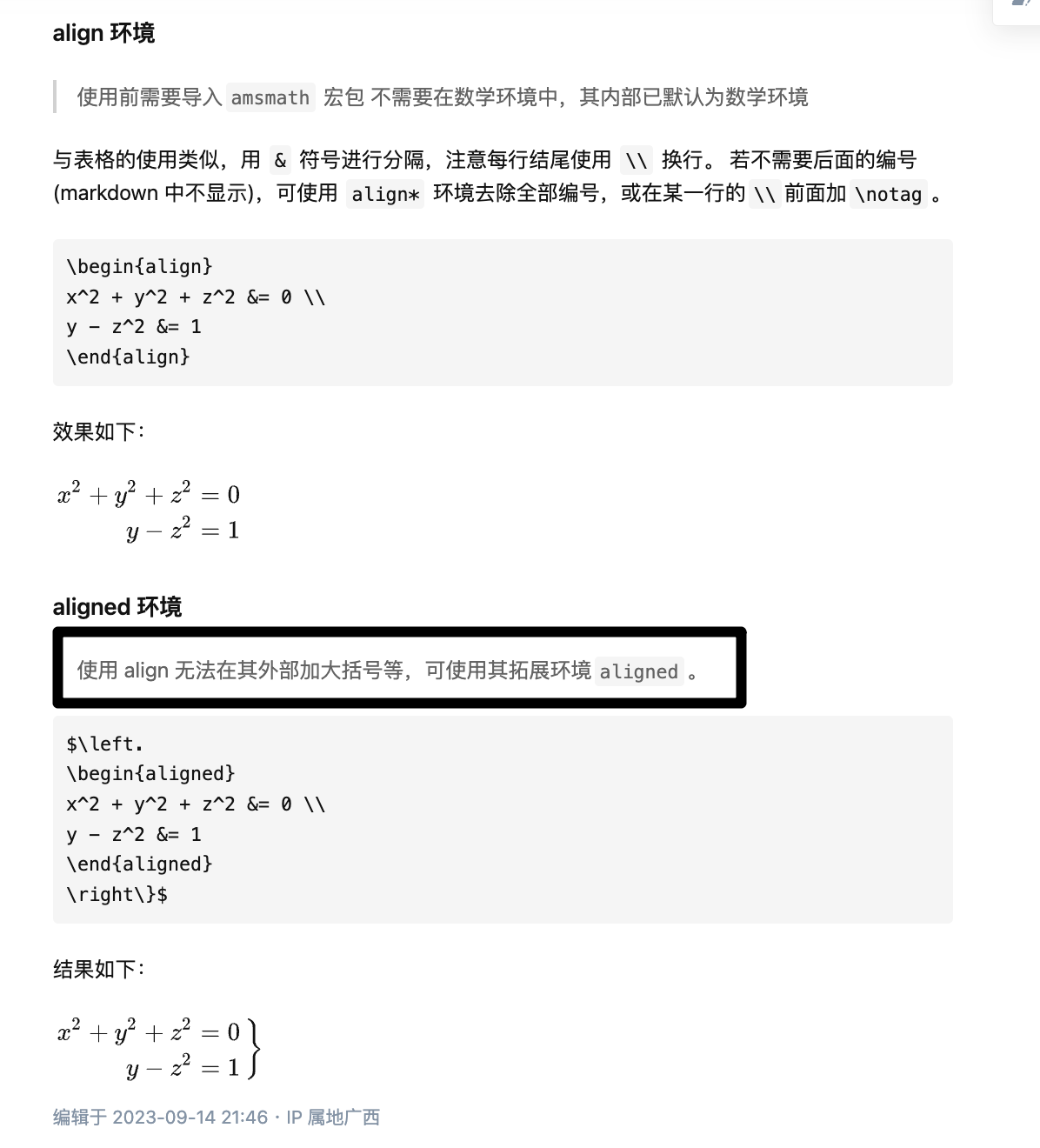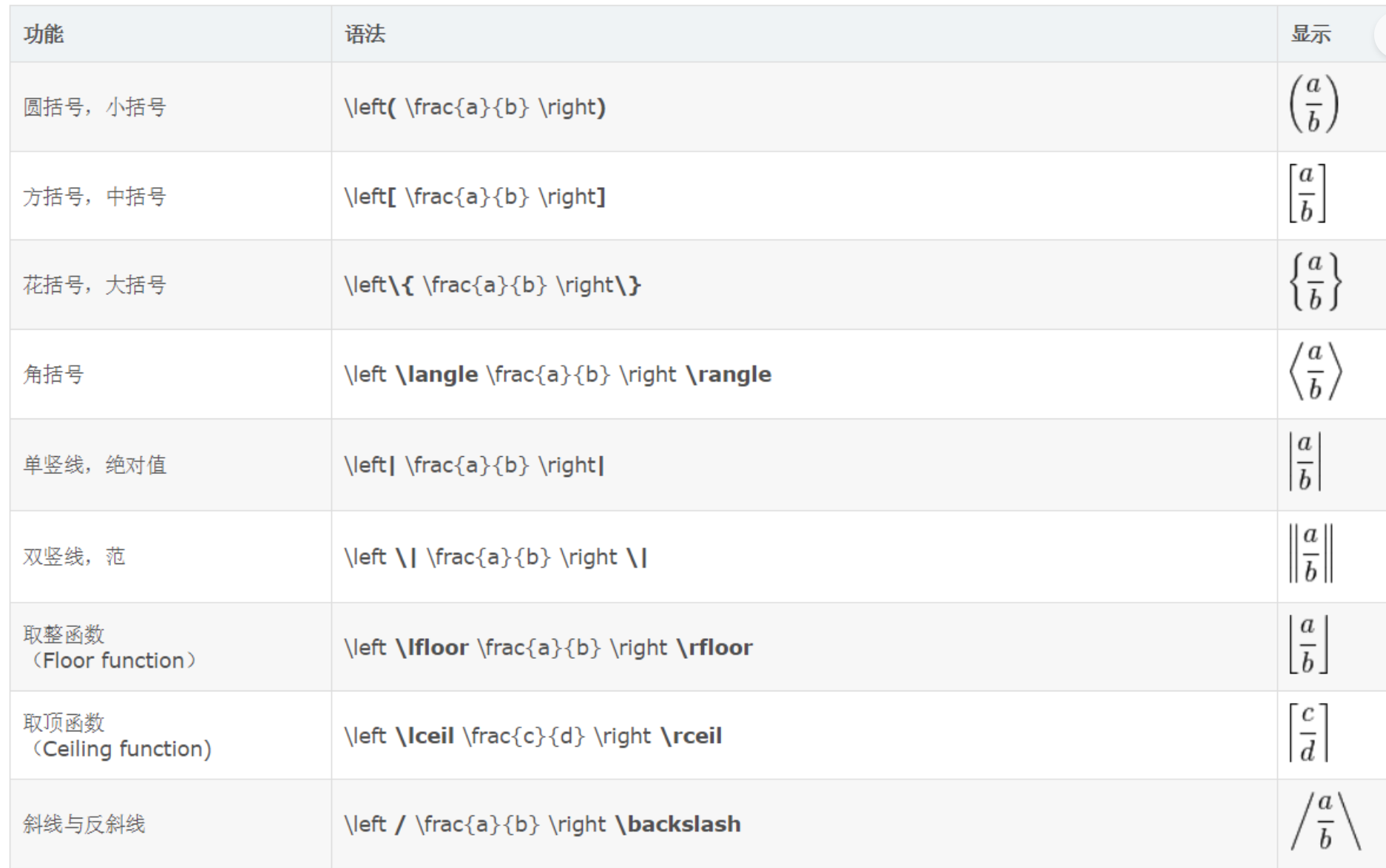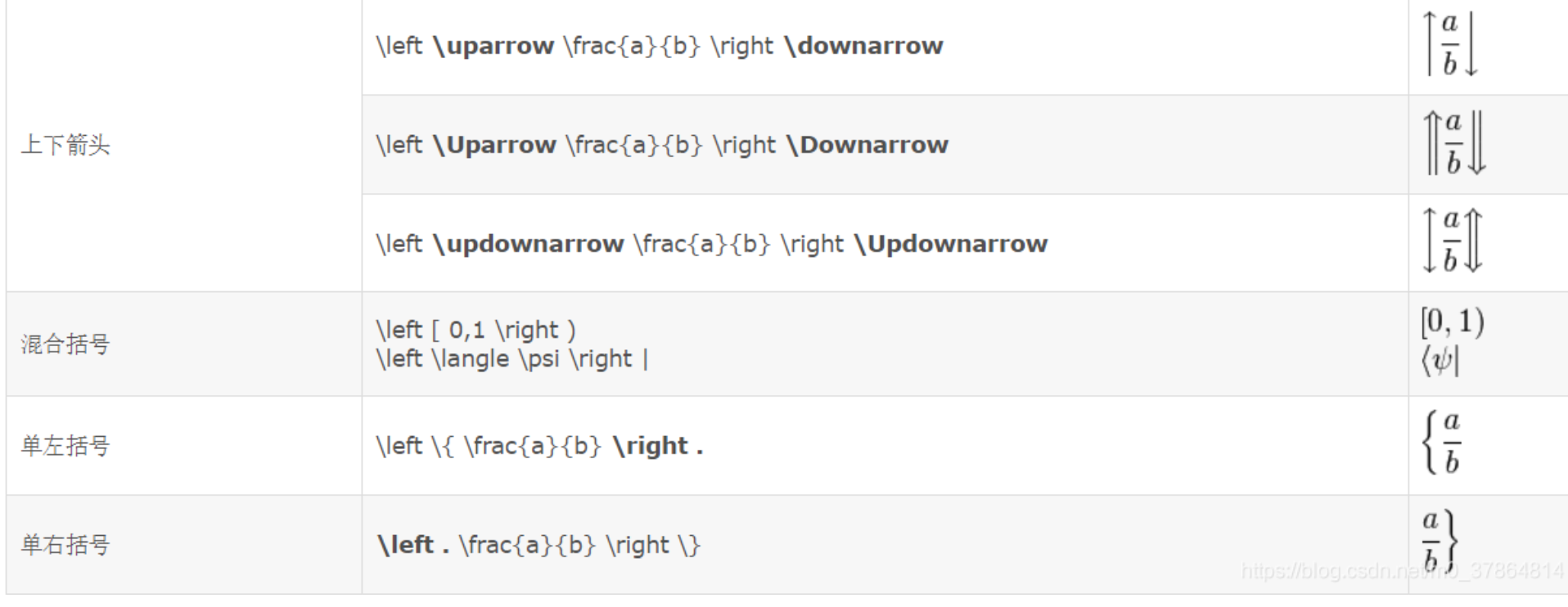LaTex¶
约 503 个字 307 行代码 5 张图片 预计阅读时间 6 分钟
latex导入包
- caption
- 对齐
- \mathbb
公式对齐一个编号¶
\begin{align}
\begin{split}
\omega&=\sum\limits_{i=1}^{m}(\hat{\alpha_i}-\alpha)x_i\\
0&=\sum\limits_{i=1}^{m}(\hat{\alpha_i}-\alpha_i) \\
C&= \alpha_i + \mu_i \\
C &= \hat{\alpha}_i + \hat{\mu}_i
\end{split}
\end{align}
多行公式对齐¶
罗马字母¶
\(\var\)
\(\varepsilon\)
\(\epsilon\)
\(\Phi\)
\(\phi\)
\(\lambda_{j}\neq0\)
\(\infty\)
\(\psi\)
加横线 \(\overline{\psi_{j}}\)
\(x^{\prime}\)
\(\kappa\)
正负号 \(\pm\)
\(\tilde{c}\)波浪线
偏导¶
在LaTeX中输入偏导数,你可以使用\frac命令和\partial符号。下面是一个简单的示例,演示如何输入一个关于变量x的偏导数:
在这个例子中,\frac{\partial f}{\partial x}表示函数f关于变量x的偏导数。你可以根据需要修改变量和函数名。
公示编号及引用¶
这是一个带有编号的公式:
在文本中引用公式 \ref{eq:emc},这是爱因斯坦的质能方程。
定义¶
\begin{definition}
(熵)分类决策树模型是一种描述对实例进行分类的树形结构。决策树由结点(node)和有向边(directed node)组成。结点有两种类型:内部结点(internal node)和叶结点(leaf node)。内部结点表示一个特征或属性,叶结点表示一个类。
\end{definition}
插入图片¶
\begin{center}
\includegraphics[width=0.5\textwidth]{figure/决策树模型1.png}
\captionof{figure}{决策树模型}
\label{fig:example}
\end{center}
如图\ref{fig:label_name}所示
\begin{center}
\includegraphics[width=0.8\linewidth]{figure/image3.png}
\captionof{figure}{支持向量回归的几何抽象}
\label{fig:支持向量回归的几何抽象}
\end{center}
\begin{center}
\includegraphics[width=1\linewidth]{figure/image2.png}
\captionof{figure}{支持向量回归}
\end{center}
当前位置三线表¶
\begin{table}[h] % 使用 [h] 选项将表格放置在当前位置
\centering
\caption{历史及实时路况信息}
\begin{tabular}{ccc}
\hline
字段名称 & 字段含义 \\
\hline
link & 数据2 \\
label & 数据5 \\
current_slice_id & 数据5 \\
future_slice_id & 数据5 \\
recent_feature & 数据5 \\
history_feature & 数据5 \\
\hline
\end{tabular}
\end{table}
在文本中插入一个三线表如下所示:
\begin{center}
\captionof{table}{这是一个三线表的例子}
\begin{tabular}{ccc}
\toprule
列1 & 列2 & 列3 \\
\midrule
数据1 & 数据2 & 数据3 \\
数据4 & 数据5 & 数据6 \\
\bottomrule
\end{tabular}
\end{center}
在表格之后的文本继续。
\begin{table}[h]
\caption{数据集示例}
\centering
\begin{tabular}{ccc}
\toprule
\textbf{序号} & \textbf{Date} & \textbf{Number of Passengers}\\
\midrule
1 & 1949/1/1 & 112 \\
2 & 1949/2/1 & 118 \\
3 & 1949/3/1 & 132 \\
4 & 1949/4/1 & 129 \\
5 & 1949/5/1 & 121 \\
... & ... & ... \\
144 & 1960/11/1 & 390 \\
145 & 1949/12/1 & 432 \\
\bottomrule
\end{tabular}
\end{table}
latex 单元格内换行¶
\begin{table}
\centering
\caption{三线表段内分行}
\begin{tabular}{ccc}
\toprule
列1 & 列2 & 列3 \\
\midrule
数据1 & 数据2 & \begin{tabular}[t]{@{}c@{}}数据3 \\ 行2\end{tabular} \\
数据4 & \begin{tabular}[t]{@{}c@{}}数据5 \\ 行1\end{tabular} & 数据6 \\
\bottomrule
\end{tabular}
\end{table}
计数列表¶
不计数列表¶
表格模版¶
\begin{table}
\caption{这是一个三线表.}
\centering
\begin{tabular}{ccc}
\toprule
\textbf{Treatments} & \textbf{Response 1} & \textbf{Response 2}\\
\midrule
Treatment 1 & 0.0003262 & 0.562 \\
Treatment 2 & 0.0015681 & 0.910 \\
\bottomrule
\end{tabular}
\end{table}
代码¶
求和号正上正下¶
\(\sum\limits_{n=0}^{\infty}2^{n} = -1\)
代码 等宽字体¶
在LaTeX中,你可以使用\texttt{}命令来显示等宽字体文本,以突出代码或库的名称。对于"Scikit-learn库\texttt{Scikit-learn}库
学术型论文常用的定理类环境的定义¶
%=================== 定理类环境定义 ===================
\newtheorem{example}{例} % 整体编号
\newtheorem{algorithm}{算法}
\newtheorem{theorem}{定理}[section] % 按 section 编号
\newtheorem{definition}[theorem]{定义}
\newtheorem{axiom}[theorem]{公理}
\newtheorem{property}[theorem]{性质}
\newtheorem{proposition}[theorem]{命题}
\newtheorem{lemma}[theorem]{引理}
\newtheorem{corollary}[theorem]{推论}
\newtheorem{remark}[theorem]{注解}
\newtheorem{condition}[theorem]{条件}
\newtheorem{conclusion}[theorem]{结论}
\newtheorem{assumption}[theorem]{假设}
\usepackage{amsmath}
\numberwithin{equation}{section} % 按 section 编号
算法格式引用¶
\begin{algorithm}
\label{alg:example}
\end{algorithm}
引用算法:算法~\ref{alg:example} 展示了一个简单的示例算法。
#插入链接
\href{https://example.com}{bagging nearest neighbor classifiers}
引用参考文献¶
latex 正体、花体¶
花体字母要调包
\mathrm{R}\(\mathrm{R}\)
\rm{R} \(\rm{R}\)
\mathbb{R} \(\mathbb{R}\)
\mathcal{R} \(\mathcal{R}\)
\mathscr{R} \(\mathscr{R}\)
latex 字母的正上方打两个点¶
\(\ddot x\)
\ddot x
定义¶
\begin{definition}{Oracle方法}
\label{def:example}
这是一个定义。
\end{definition}
在定义~\ref{def:example} 中我们可以看到...
引用¶
- 图片
- 公式
- 参考文献
- 附录
- 表格
- 定义
- 定理
打波浪线¶
\(\widetilde{{\beta}}=A\boldsymbol{y}\)
小于等于大于等于¶
\(\begin{aligned}1\leqslant j\leqslant p\end{aligned}\)
大帽子¶
\(\widehat{\mathcal{M}_d}\)
公式水平对齐 去掉公式编号¶
打括号¶
字体加颜色¶
首先,在最前面的导言区输入命令 **\usepackage{color}**,然后,在需要加注颜色的处输入**{\color{red}{I love you}}**,最外面的大括号是只对“I love you”加注红色,如果没有这个大括号的话,那会对后面所有的文本加颜色。如果要对公式加注颜色,只需要将文字“I love you”换成公式的命令就可以了,如:要对公式*A*(*x*)加颜色,输入{\color{red}{$*A*(*x*)$}}就可以了。
三线表¶
\begin{table}
\caption{这是一个三线表.}
\centering
\begin{tabular}{ccc}
\toprule
\textbf{Treatments} & \textbf{Response 1} & \textbf{Response 2}\\
\midrule
Treatment 1 & 0.0003262 & 0.562 \\
Treatment 2 & 0.0015681 & 0.910 \\
\bottomrule
\end{tabular}
\end{table}
\begin{table}[!htp]
\centering
% PLCR已经定义
\caption{某校学生身高体重样本.}
\label{tab2:heightweight}
\begin{tabular}{lccc}
\toprule
序号&年龄&身高&体重\\
\midrule
1&14&156&42\\
2&16&158&45\\
3&14&162&48\\
4&15&163&50\\
\cmidrule{2-4}
平均&15&159.75&46.25\\
\bottomrule
\end{tabular}
\end{table}
latex空 2 行¶
\vspace{2ex}
latex beamer 行间距¶
\linespread{2}
latex 多行公式¶
\begin{equation}
\left\{
\begin{array}{lr}
x=\dfrac{3\pi}{2}(1+2t)\cos(\dfrac{3\pi}{2}(1+2t)), & \\
y=s, & 0\leq s\leq L,|t|\leq1.\\
z=\dfrac{3\pi}{2}(1+2t)\sin(\dfrac{3\pi}{2}(1+2t)), &
\end{array}
\right.
\end{equation}
\begin{equation}
\begin{aligned}
\begin{split}
& \min_{ \omega,b} \quad\frac{1}{2}|| \omega||^2 + C \sum \limits_{i=1}^m(\xi_i + \hat\xi_i)\\
& st. \left\{ \begin{array}{ll} f(x_i)- y_i \leq \epsilon + \xi_i \\ y_i-f(x_i)\leq \epsilon + \hat{\xi}_i \\ \xi_i >0,\hat{\xi}_i>0 \end{array} \quad \quad i=1,2,3,...,m \right.
\end{split}
\end{aligned}
\end{equation}
\begin{equation}
\begin{aligned}
\begin{split}
\end{split}
\end{aligned}
\end{equation}
beamer 一点一点的出来的动画¶
\subsection{作者在这篇综述中具体讲了什么? }
\begin{frame}{Frame Title}
The main issues and contributions of this paper are as follows:
\begin{itemize}[<+->]
\item Contribution 1: ...... ;
\item Contribution 2: ...... ;
\item Contribution 3: ...... ;
\end{itemize}
\end{frame}
beamer 算法跨页¶
\documentclass{beamer}
\usefonttheme{serif}
\usetheme{Warsaw}
%%=====================================================================================
%算法宏包
\usepackage{algorithm,algpseudocode}
\makeatletter
\newenvironment{breakablealgorithm}
{
\begin{center}
\refstepcounter{algorithm}% New algorithm
\hrule height.8pt depth0pt \kern2pt% \@fs@pre for \@fs@ruled
\renewcommand{\caption}[2][\relax]{% Make a new \caption
%{\raggedright\textbf{\textbf{算法}~\thealgorithm} ##2\par}%
{\raggedright\textbf{\ALG@name~\thealgorithm} ##2\par}%
\ifx\relax##1\relax % #1 is \relax
\addcontentsline{loa}{algorithm}{\protect\numberline{\thealgorithm}##2}%
\else % #1 is not \relax
\addcontentsline{loa}{algorithm}{\protect\numberline{\thealgorithm}##1}%
\fi
\kern2pt\hrule\kern2pt
}
}{
\kern2pt\hrule\relax %\@fs@post% for \@fs@ruled
\end{center}
}
\makeatother
%===========================================================================================
\newcommand{\rr}{\tilde{r}_{0}}
\begin{document}
%%=====================================================
\begin{frame}[allowframebreaks]
\begin{breakablealgorithm}
\caption{Your Algorithm}%算法标题
\begin{algorithmic}[1]%一行一个标行号
******************************
******************************
******************************
%%*为算法具体内容
\end{algorithmic}
\end{breakablealgorithm}
\end{frame}
\end{document}




